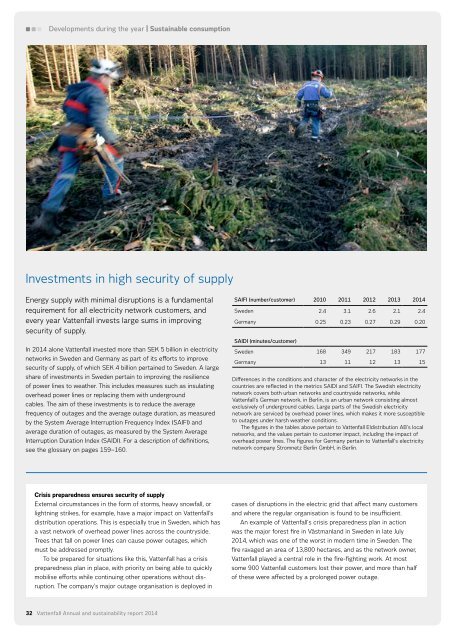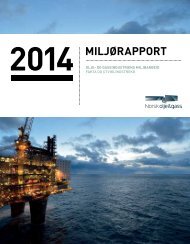annual-and-sustainability-report-2014
annual-and-sustainability-report-2014
annual-and-sustainability-report-2014
You also want an ePaper? Increase the reach of your titles
YUMPU automatically turns print PDFs into web optimized ePapers that Google loves.
Developments during the year | Sustainable consumptionInvestments in high security of supplyEnergy supply with minimal disruptions is a fundamentalrequire ment for all electricity network customers, <strong>and</strong>every year Vattenfall invests large sums in improvingsecurity of supply.In <strong>2014</strong> alone Vattenfall invested more than SEK 5 billion in electricitynetworks in Sweden <strong>and</strong> Germany as part of its efforts to improvesecurity of supply, of which SEK 4 billion pertained to Sweden. A largeshare of investments in Sweden pertain to improving the resilienceof power lines to weather. This includes measures such as insulatingoverhead power lines or replacing them with undergroundcables. The aim of these investments is to reduce the averagefrequency of outages <strong>and</strong> the average outage duration, as measuredby the System Average Interruption Frequency Index (SAIFI) <strong>and</strong>average duration of outages, as measured by the System AverageInterruption Duration Index (SAIDI). For a description of definitions,see the glossary on pages 159–160.SAIFI (number/customer) 2010 2011 2012 2013 <strong>2014</strong>Sweden 2.4 3.1 2.6 2.1 2.4Germany 0.25 0.23 0.27 0.29 0.20SAIDI (minutes/customer)Sweden 168 349 217 183 177Germany 13 11 12 13 15Differences in the conditions <strong>and</strong> character of the electricity networks in thecountries are reflected in the metrics SAIDI <strong>and</strong> SAIFI. The Swedish electricitynetwork covers both urban networks <strong>and</strong> countryside networks, whileVattenfall’s German network, in Berlin, is an urban network consisting almostexclusively of underground cables. Large parts of the Swedish electricitynetwork are serviced by overhead power lines, which makes it more susceptibleto outages under harsh weather conditions.The figures in the tables above pertain to Vattenfall Eldistribution AB’s localnetworks, <strong>and</strong> the values pertain to customer impact, including the impact ofoverhead power lines. The figures for Germany pertain to Vattenfall’s electricitynetwork company Stromnetz Berlin GmbH, in Berlin.Crisis preparedness ensures security of supplyExternal circumstances in the form of storms, heavy snowfall, orlightning strikes, for example, have a major impact on Vattenfall’sdistribution operations. This is especially true in Sweden, which hasa vast network of overhead power lines across the countryside.Trees that fall on power lines can cause power outages, whichmust be addressed promptly.To be prepared for situations like this, Vattenfall has a crisispreparedness plan in place, with priority on being able to quicklymobilise efforts while continuing other operations without disruption.The company’s major outage organisation is deployed incases of disruptions in the electric grid that affect many customers<strong>and</strong> where the regular organisation is found to be insufficient.An example of Vattenfall’s crisis preparedness plan in actionwas the major forest fire in Västmanl<strong>and</strong> in Sweden in late July<strong>2014</strong>, which was one of the worst in modern time in Sweden. Thefire ravaged an area of 13,800 hectares, <strong>and</strong> as the network owner,Vattenfall played a central role in the fire-fighting work. At mostsome 900 Vattenfall customers lost their power, <strong>and</strong> more than halfof these were affected by a prolonged power outage.32 Vattenfall Annual <strong>and</strong> <strong>sustainability</strong> <strong>report</strong> <strong>2014</strong>



